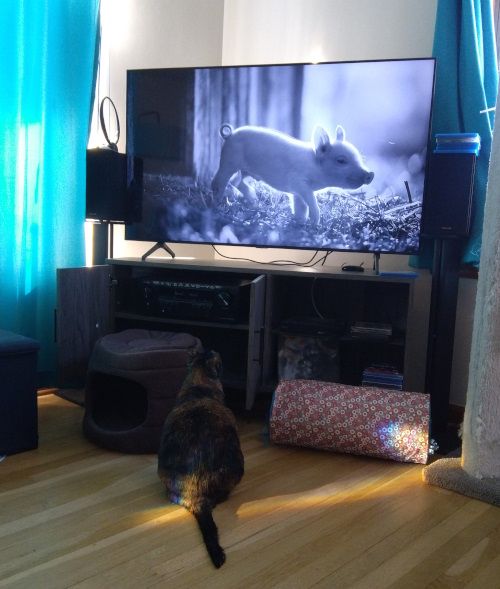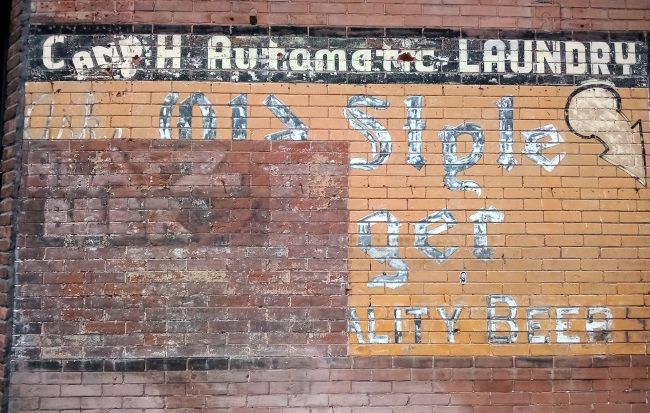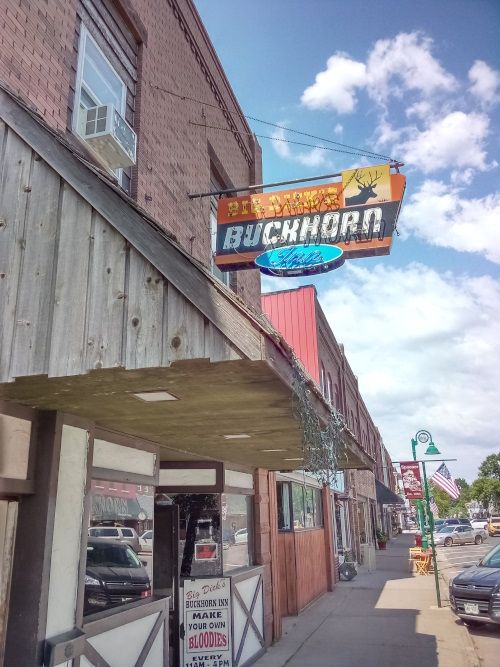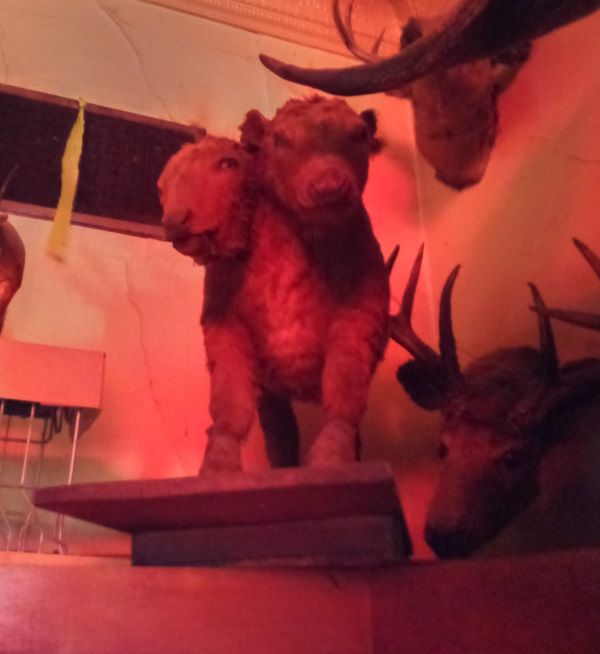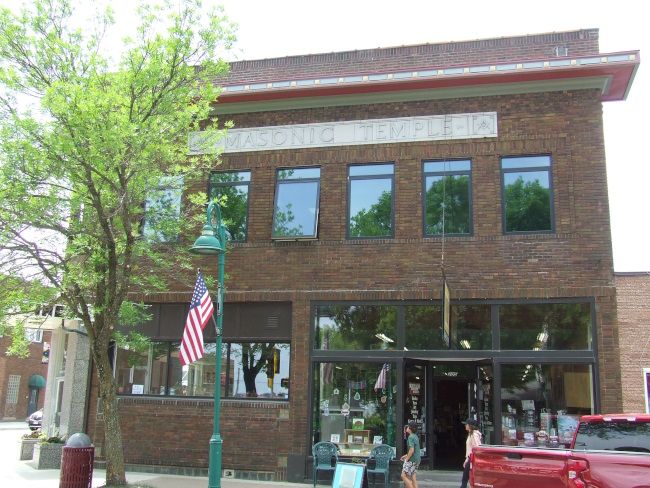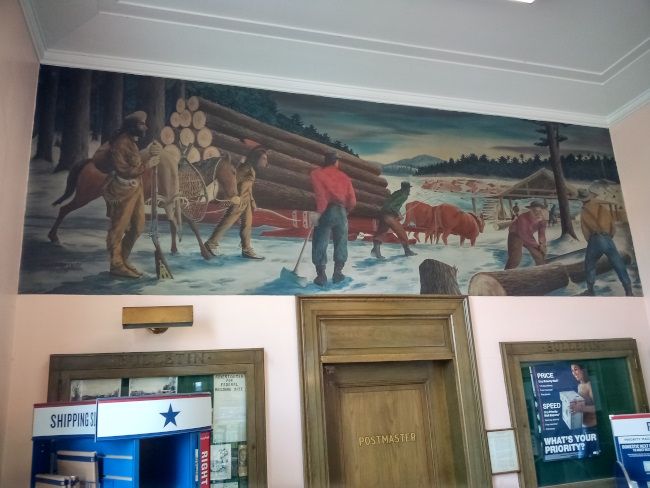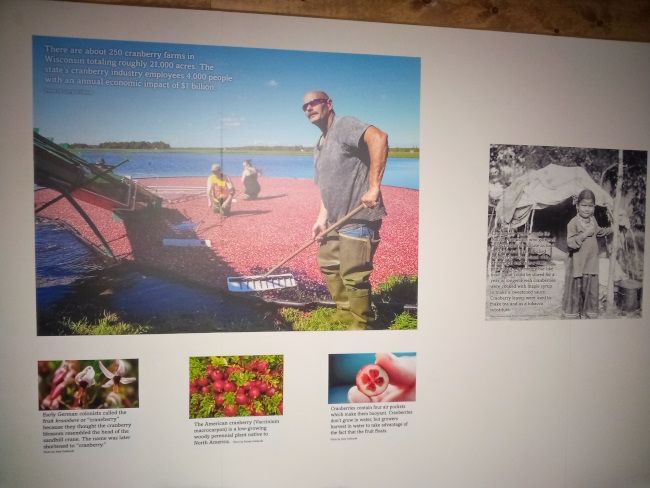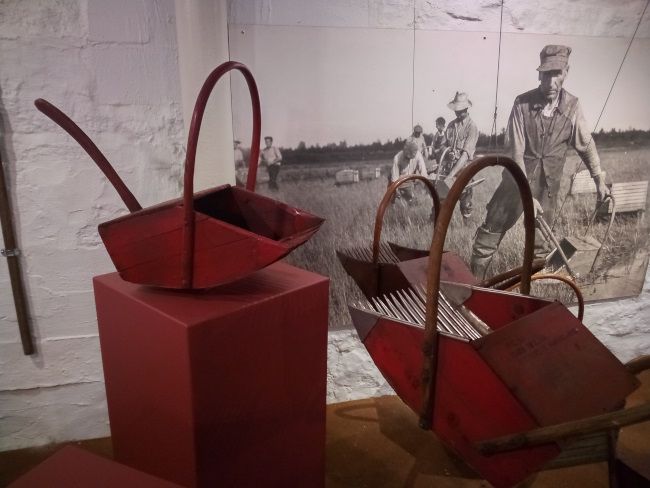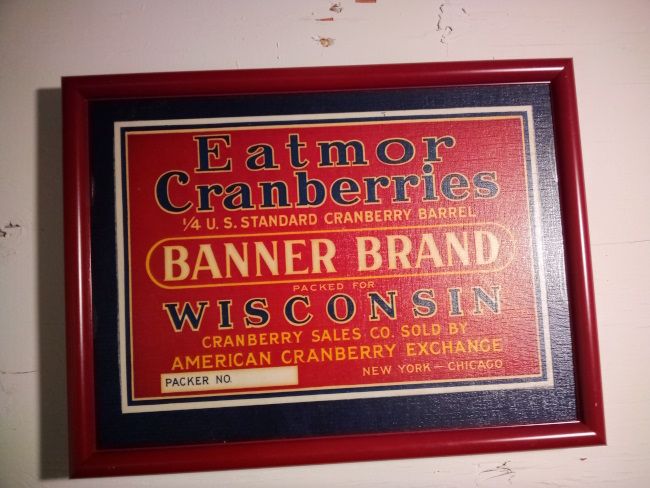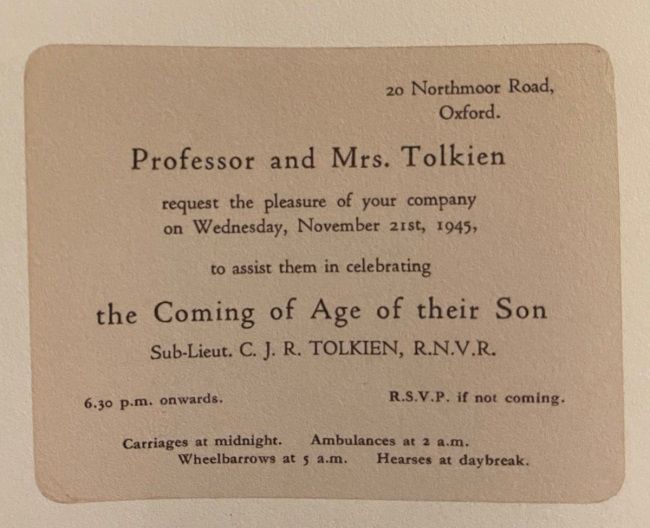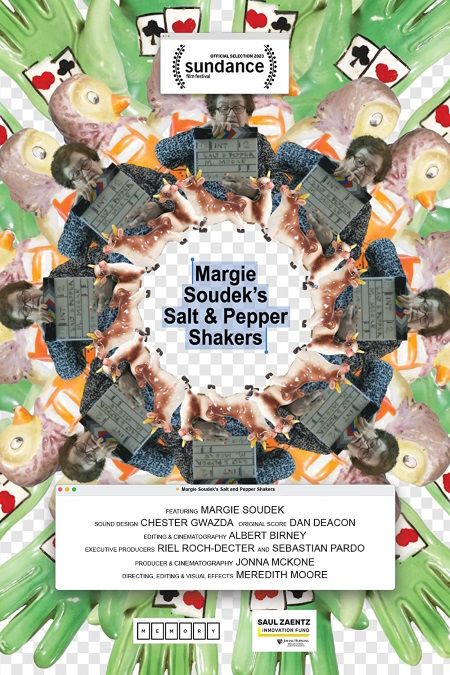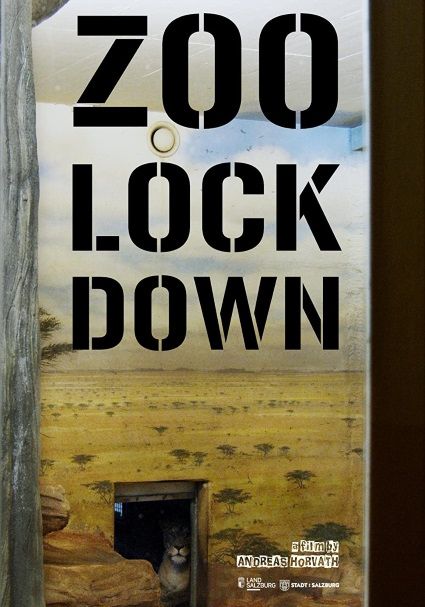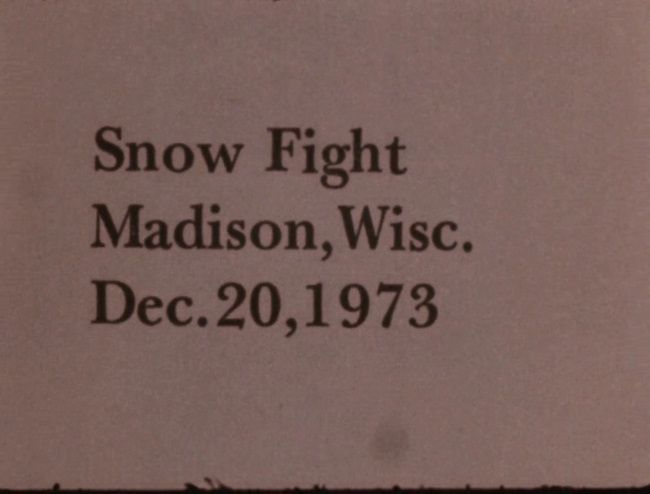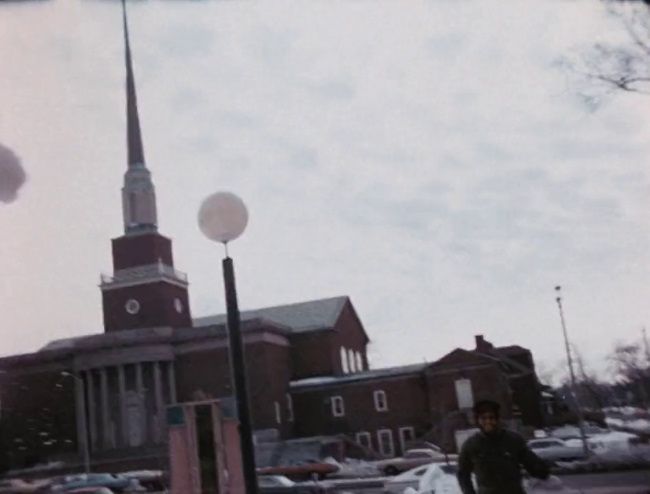Ooh! There's a documentary coming out next month about Sly and the Family Stone called SLY LIVES! (aka The Burden of Black Genius). Unfortunately, it looks like it won't get a theatrical run and will instead be available only on Hulu. I don't think we have Hulu anymore but will have to check on that. Look for it starting the 13th.
24 January, 2025
SLY LIVES! (aka The Burden of Black Genius)
19 December, 2024
IN DORSET NO ONE CAN HEAR YOU SCREAM!
This looks like a fun documentary and I am jealous of folks who got to see the show.
Alien On Stage is a Documentary about a unique crew of Dorset Bus Drivers whose amateur dramatics group decide to ditch doing another pantomime and try something different.
Having never done anything like it before, they spent a year creating a serious adaptation of the sci-fi, horror film, Alien; finding ingenious solutions to pay homemade, homage to the original film.
The show is a crushing flop but fate gives them a second chance to find their audience. Whilst still adjusting to the idea that their serious show is actually a comedy, the group find out they’re suddenly being whisked from their village hall to a London West End theatre to perform this accidental masterpiece for one night only.
With wobbly sets, awkward acting and special effects requiring 'more luck than judgement’, will their West End debut be alright on the night? This bus driving crew are our space heroes. Their bus station is our space station. Dorset is outer-space and where is the Alien? It’s behind you!
12 December, 2024
Errol Morris & Jacob Soboroff on Separated
Perhaps our greatest living documentarian (and University of Wisconsin-Madison alumnus), Errol Morris, has a new movie out called Separated which looks at the Trump administration’s policy of separating children from their aspiring immigrant parents at our southern border. It's based on the book Separated: Inside an American Tragedy by journalist Jacob Soboroff. Sadly, it seems that it had a very brief theatrical run in New York to qualify for Academy Awards and will only be available to stream. It comes to Amazon and Apple TV on the 17th of this month. Perhaps a DVD/Bluray release...?
The pair were recently interviewed on ReasonTV and it was very interesting - and disturbing.
03 December, 2024
14 June, 2024
IMAX docs return for the summer
I heard some good news: our AMC cinema out in Fitchburg with an IMAX screen is bringing back a series of documentaries this summer. While it was my hope that they'd start screening them again on Sunday mornings as they used to, the flicks are instead going to be screened on Tuesday mornings while I am at work. Bummer.
Adults like 3D IMAX docs too, AMC.
6/18 - Under the Sea 3D
6/25 - Island of Lemurs: Madagascar 3D
7/2 - Deep Sky
7/9 - Under the Sea 3D
7/16 - Deep Sea 3D
7/23 - Born to be Wild 3D
7/30 - Deep Sky
02 February, 2024
The Past Is Not Through With Anselm Kiefer
Maybe 10 or 15 minutes in, I thought to myself how much I was enjoying a documentary that was stylistically 180 degrees from Ken Burns. Rather than hearing an omniscient narrator telling me things about German artist Anselm Kiefer, I was seeing his sculpture and paintings in glorious 3D and watching as he goes about his day in his studio.
I'd never heard of Kiefer but I think Wim Wenders does him justice here with a look at his art, which seems to come in one size only - large scale. Themes of German history and the Holocaust are prominent and inspiration comes from the poems of Paul Celan, another artist whom I'd never heard of until seeing this movie.
Anselm is a mix of styles. In some scenes, we see Kiefer at work in his outsized studio which is in a former brick factory. All that space is needed to create his pieces which are usually rather large. Does the size confront the viewer? Or is it meant to make the viewer feel dwarfed or, perhaps, overwhelmed? In others, the camera examines some of his art installations. At first we see them from afar, in toto, the voyeuristic camera hovering just outside their confines. It then gracefully moves into the installation and through them, stopping briefly to let us see the individual statues before moving onto the next one.
There are also reenactments showing us Kiefer as a boy and as a younger man as well as staged scenes in the present day, such as those with the artist taking a break and lying down with a volume of Celan's poetry.
But we don't get much straightforward info about the man or his work. There's no sense of working through his career chronologically with various periods where a certain media is used and/or a prominent theme emerges.
Just a wonderful mix of scenes that add up to an intriguing, impressionistic portrait of Anselm Kiefer.
The 3D brought the art to life, gave it an immediacy, and made me wish I'd seen Wenders' Pina, a previous documentary also shot for 3D.
Many thanks to UW Cinematheque for hosting the screening.
21 January, 2024
At the movies with Piper
Piper and I watched Gunda today and she really got into it for a spell.
01 November, 2023
The Corona Diaries Vol. 96: She wore a kraanbere beret
(mid-June 2023)
(Watch the prelude.)
Leaving Trego after a couple hikes, I headed south to Spooner. I had been there many times but probably not since I was a boy in the early ‘80s. When my family owned an old resort a bit to the east, we’d visit Spooner on occasion. The women and kids did a spot of shopping and perused the library while the men, if I recall correctly, paid a visit to hardware store and/or lumberyard (and probably the tavern too) which was larger than the one found in Stone Lake, the town nearest our cabins.
Although my mother can rattle off various memories of Spooner, I drove in and found that nothing at all looked familiar, unlike Hayward. I suspect that, if Spooner had a candy shop with people making fudge in the front windows, I would have vivid memories of it.
Back in the day, it was quite the rail town with nearly 20 passenger trains stopping there plus many others carrying freight and logs aplenty. This was the pinery, after all. I suppose the mail came via the train back in the day as well. Sadly, the museum was not open when I was there so I had to make do with wandering around the grounds which included this out in front.
I presume that this behemoth cleared the tracks of snow, wayward cows, damsels in distress tied to the rails or just whatever happened to be on the tracks when it was cruising along.
My stomach growled so I went in search of lunch. On my way, I passed by this wonderful ghost sign.
Two different brands of beer and an "automatic laundry".
"Was that the phrase used before the word 'laundromat' was invented?" you ask?
Why yes, I did just consult my Compact OED on this matter. "Laundromat" was trademarked by Westinghouse as a name for a washing machine in 1943. Its first use as a word for a place with such washing machines for the public to go wash their clothes dates to 1951.
So, does "automatic laundry" = "laundromat"? Definitely maybe.
I ended up at a Mexican restaurant which was plenty fine and a nice change of pace from the more generic American/bar food I’d mostly eaten on the trip. It can get depressing looking for a meal in small town Wisconsin because it seems like 95% of the food on offer is either a pizza or a hamburger with much of the remaining 5% dedicated to Friday fish fries and deep fried cheese curds. And here I discount fast food. Nothing wrong with any of these foods, but they get old quickly. How about a venison chop or some kielbasa or Swedish/Norwegian meatballs or just about anything that isn't a pizza or hamburger?
For dessert I walked over to Big Dick’s Buckhorn Inn where I would have a refreshing glass of beer. Or two. It was, by this time, afternoon.
I walked in and found that it was a classic northern Wisconsin tavern and probably put some taxidermist’s kids through college as it was filled with mounted deer heads. It had a lovely pressed tin ceiling and a lot of wood making up in the interior. Unfortunately, the bright glow from a plethora of video poker machines cut through the rustic ambiance like a hot knife through butter.
Tucked away in a corner was a two-headed calf.
Whether this is some taxidermist’s joke or the real deal remains unknown to me. Like Mulder in The X-Files, I want to believe so I didn’t ask the bartender nor have I consulted the internet for an answer.
When the situation calls for a little lavatory one-upmanship, I can now brag that I have peed where John F. Kennedy peed.
In the late winter/early spring of 1960, JFK was campaigning in Wisconsin for the 1960 Democratic nomination for president against Hubert H. Humphrey. Their time spent shaking hands and kissing babies in the Badger State was captured in the landmark documentary, Primary. It’s been a while since I’ve seen it and I don’t recall a scene with JFK at Big Dick’s.
Primary is famous for being the start of direct cinema here in the United States. Direct cinema being that fly on the wall technique of the camera capturing events with no deep-voiced narrator to authoritatively tell us what’s going on nor any interviews with the subjects. The camera simply records what unfolds before it. Primary was made by a who’s who of American direct cinema: Robert Drew, Richard Leacock, D. A. Pennebaker, and Albert Maysles. These guys are giants of American documentary cinema, in general, really.
I recall a scene where Humphrey is standing out on a street in Tomah talking to passers-by and I do believe we see JFK speaking in Madison at the Stock Pavilion down on campus.
See! I have applied something I learned in college in real life.
I wandered Spooner a bit more and found that the old Masonic Lodge was now shops, including a nice little bookstore.
Surely there were Masons here during JFK’s visit and I don’t doubt they reported on his whereabouts to the Mafia/Castro/CIA or whoever it was that killed him. Ha!
As I was perusing the shelves in search of postcards, there was a knitting circle that had gathered in the back. I overheard some of their conversation which included one older woman talking about living in Costa Rica during her younger days, including the advantages and pitfalls of raising a family there. It was not the conservation I expected when I started eavesdropping.
I checked into my hotel, showered, and relaxed for a while. When I was younger, I felt that lounging around a hotel room was a waste of time. Why sit around when you're away from home when you can wander a foreign place and try to discover whatever it has to offer? I mean, Port and Kit Moresby didn't just sit around their hotel rooms, right? They cruised around Algeria where they met fellow tourists, engaged with, um, working girls, and fled from the local demimonde. (OK, it's been a while since I've read The Sheltering Sky.)
These days I am happy to spend a little time at a hotel to do some reading and/or writing and let my feet recuperate from hoofing it for several miles through the woods. Late evening rolled around and I went out for dinner to some diner that I had spied earlier. Like Chetek, I found no sign of a supper club in or near Spooner. Very weird. It feels like an unwritten law is being broken here or some Wisconsin taboo is being violated.
Although the waitresses at the restaurant were amongst the cutest so far on my trip, the food was the worst. My meatloaf was a Sysco special with gravy from a #10 can. The frozen vegetable medley had been sitting in a steam tray for hours and had taken on a dull, lifeless brown tint with every bite a mushy mess and all vitamins having been leached out. All those kernels of corn, carrots, and peas deserved a better fate.
I returned to the hotel after taking a post-prandial stroll disappointed with dinner but at least I had a full belly. Had the local brewpub, Round Man Brewing, been open, I'd have stopped in for a nightcap but, alas, it was not. A bit more reading and writing was accomplished.
The next morning I stopped at a nice coffee shop and walked around town a bit more. I wanted to find the library to see if it jogged my memory as my mother always mentions it when Spooner comes up in conversation.
It didn’t but I did get to see a neat metal sculpture out front.
Sadly, this was the final day of my vacation. But I vowed to take my time getting home and made a couple of stops to savor every moment of not being at work that I could.
A brief sojourn at a rest area revealed a genuine working pay phone there. It wasn't clear to me if calls to numbers other than 911 would go through.
I eschewed the interstate and continued on Highway 53 south of Eau Claire. Just south of Osseo I went hunting for a geodetic survey marker. These markers are used to designate some kind of survey information such as an exact distance above sea level or a precise measurement of distance from the equator down to the arc second or whatever it is that surveyors need to know.
I heard of these in a blog post by Ryan Urban, editor of the Barron News-Shield whom I was Twitter pals with and met in real life on my trip up north last year.
The site detailing locations of these markers didn’t lie. I pulled my car over by the road sign specified and walked into the grass where 3 posts stood. In the middle was the marker. It was easy to find and had only a few years of dead grass on it instead of decades worth of dirt like the one Ryan unearthed.
Next stop was Black River Falls.
The downtown wasn’t looking good. Lots of empty storefronts and not much in the way of foot traffic. But that is where the post office is and I was there to take a picture of its mural.
Seeking out WPA post office murals is another thing that I discovered via Ryan Urban who is in the process of photographing all of the ones in Wisconsin.
This one is called "Lumbering - Black River Mill" and was painted by Frank E. Buffmire in 1939. The internet has little to say about the man, at least from my meager searches.
A stop at the Black River Falls rest area proved interesting as I learned from a historical marker that Wisconsin is the only state in the nation that commercially produces sphagnum moss. It can hold 20 times its weight in water so it’s used in the shipment of plants and hydroponic gardening, amongst other uses.
When I drive to Indianapolis, I am used to seeing countless billboards on Illinois-Indiana highways for law firms promising the wealth of Croesus to accident victims. Well, on this trip I noticed the Wisconsin equivalent.
I don’t recall seeing these billboards last year. Are they really that new? Or is my memory faulty? And who is this bald and bearded neo-Gerry Spence?
My final stop before home was at the Wisconsin Cranberry Discovery Center & Cranberry Country Café in Warrens. I can’t say I’d ever been to Warrens but have seen the billboards out on the interstate advertising the town’s cranberry festival that is held annually on the last the last full weekend of September. Not only are we the nation’s leader in sphagnum moss production but cranberries as well.
Warrens proper is just east of the interstate. It’s a nice little drive into town whereupon you notice that there isn’t much to it. With a population of just around 350 people, you’ll miss it if you blink while driving through. There’s a gas station, a post office (with no WPA mural), and the Cranberry Discovery Center. That is basically it.
I ordered breakfast at the café. The 2 waitresses were young black women, a sight I certainly didn’t expect in small town Wisconsin. Warrens lies in Monroe County which is (or was, anyway) Trump territory but, despite all the hoopla about Trump voters being a bunch of racists, if anyone cared about the color of their skin, they weren't at the café. A couple old ladies chatted with them as old ladies like to do with young folk.
My breakfast included wild rice-cranberry toast which was quite tasty. Wild rice-cranberry bread is one of the quintessential foods of northern Wisconsin. Hell, the Upper Midwest, really. A rye version would be the bee's knees, if you ask me.
After chowing down, I went downstairs to the Discovery Center. I learned that Warrens was originally – quelle surprise! – a logging town and was named after George Warren. When the pinery was all cut down, agriculture and diary became big in the area and this included the harvesting of sphagnum moss. Apparently no one knows for sure when cranberries were first cultivated in Warrens for commercial production but they date back to the 1870s.
Displays explain how cranberries are grown and harvested. They don’t grow in water but are harvested in it. In the photo below, you can see those hollow spaces in the cross section of a cranberry. The air in those little cavities allows them to float. So cranberry bogs are flooded so that the berries can be picked more easily.
On display were examples of the harvesting tools such as these hand rakes.
I also learned that early German settlers called the fruit a “craneberry” (kraanbere) because the blossom looked like the head of a sandhill crane to them. It eventually became “cranberry”.
As with most foods, I have always thought that a cranberry is a cranberry is a cranberry. Not so. If the packaging at the store doesn't specify a variety of a fruit or vegetable, it just become this single, nebulous food in my mind. There are various strains of the cranberry and my alma mater, the UW-Madison, devised one called HyRed which became available in 2003 for commercial use. Apparently, it turns red earlier than other varieties and has more pigmentation making for a deeper red hue.
There were also various advertisements to be seen.
"Eatmor". Now that's some fine marketing acumen on display there.
On the way out of town, I pulled over to check out the cranberry vines growing in their bogs. Come the fall, they’ll be filled with water and harvesters will do their thing and my local grocery store will have fresh cranberries ready for Thanksgiving. Unless, I suppose, they end up at some Ocean Spray factory.
********
Bonus photo. I found this one online. It’s an invitation to celebrate the 21st birthday of Christopher Tolkien, the youngest son of J.R.R. Tolkien, the author of The Hobbit and The Lord of the Rings books.
When I first encountered it online, people were commenting on the bits at the bottom about ambulances at 2 a.m. and hearses at daybreak. While it's quite funny and belies the image of Tolkien as this serious academic who sat around all day making up the Elven language for his novels, I took notice of how the Tolkiens called their son’s 21st birthday his “coming of age”. We don’t talk like that much anymore. Catholics have confirmation and Jews have bar and bat mitzvahs but such things are generally a thing of the past for us here in the United States.
I attended the bat mitzvah of the daughter of one of the Frau’s friends and it was wonderful. Coming-of-age rituals have simply gone out of fashion, sadly. I read or heard someone discussing this recently and they made an interesting observation.
This person opined that most cultures hold that womanhood is attained when a girl starts menstruating. Boys, however, become men not via a biological process, but rather through a ritual of some kind. Maybe by going out hunting with the men of your tribe/village/family and killing your first beast. Or perhaps through some kind of hazing. The interviewee offered the example of some culture that I cannot recall where boys become men by being beaten for a time. Not within an inch of their life, mind you, but they have to endure a prescribed amount of pain in order to be considered a man.
Since I'm no sociologist nor cultural anthropologist, I can't vouch for the veracity of these comments but I nevertheless find them interesting.
30 August, 2023
It's awfully considerate of you to think of me here
Recently there were a couple of screenings of Have You Got It Yet? The Story of Syd Barrett and Pink Floyd and of course I was in the audience for one.
The movie was co-directed by Roddy Bogawa, whom I’d never heard of, and Storm Thorgerson, friend of Syd Barrett (and Roger Waters) starting in childhood. Thorgerson, a graphic designer by trade, co-founded Hipgnosis which devised most Pink Floyd album covers plus countless others for a bevy of bands.
The movie is a typical mix of archival photos and film along with talking head interviews by the members of Pink Floyd – minus Richard Wright, and a variety of Barrett’s friends, former lovers, and his sister. Thorgerson is the interviewer here and, since he died in 2013, these interviews are likely 12 years old or thereabouts.
But this doesn’t really matter. Since he personally knew most of the people he talks to, the interviews are more like conversations and have an ease about them that most documentaries lack. They often come across as friends having a chat and reminiscing rather than someone investigating a subject and scrutinizing their interlocutor. No music journalists are consulted for an “objective” view and, aside from a couple television clips featuring Barrett on TV, all of the interviews seem to have been done just before Thorgerson’s death. This movie is a bunch of people who mostly know one another looking back at the days of their youth and mourning the loss of their friend, lover, brother.
Very early on, we are given orthodox rock history: Barrett took too much acid and it fried his brain so he had to leave Pink Floyd and become a recluse. We then get an account of our tragic hero's childhood and see him mature into a handsome young man who joins a band doing American blues and R&B songs. They abandon the trendy covers act and go their own way. Barrett re-christens the group Pink Floyd and the rest is history.
Friends gush about Barrett’s charisma and playfulness while fellow musicians can say nothing less about his musical and songwriting talents than he was simply a genius. Former girlfriends describe how they were attracted to his quirky personality. One of them says something to the effect of a goofy musician being a much more attractive proposition than a banker. So there’s an element of hagiography here.
But we also get some great early Floyd footage. Presumably the filmmakers were given access to people’s private collections of old 8mm or 16mm films from back in the day. I’m not intimately familiar with the extant Syd-era footage so perhaps the movie features stuff largely already available. Regardless, that scene of them playing “Astronomy Domine” with the psychedelic liquid projection and the lights, in color, no less, was just fantastic. Like most music documentaries, Have You Got It Yet? suffers from the we-can’t-play-a-whole-song syndrome. But I did appreciate that “Bike” got an extended examination.
In the latter part of 1967 Barrett started to lose it, I guess you’d say. One interviewee says that the burgeoning pop star simply didn’t want to be in the music business anymore, that the taste of fame he'd already had was enough. While I can certainly believe this, his behavior and eventual seclusion suggests there was more to it than that. He became withdrawn and undependable. At first, David Gilmour was brought in to augment the increasingly erratic front man but he would go on to replace him. I was happy that “Vegetable Man” and “Scream Thy Last Scream Old Woman With a Casket”, Barrett songs from his last days with the band, were brought up as I adore both of them.
He was kicked out of Pink Floyd in 1968 at the tender age of 22 and his recording career was done within a couple of years. I had no idea that he occasionally played gigs with other folks until 1974 or so but we find out that he did. The section of the movie where Barrett turns up at the Floyd’s recording session for Wish You Were Here in 1975 was heartbreaking.
At first, the band didn’t know who he was. Someone – I cannot recall whom – noted that he had a new still camera in the studio that day and took some photos of the revenant band leader in the control booth that I had never seen. We are told that Barrett picked up a guitar and strummed a bit as the band looked on, not quite knowing what to do or say.
Barrett lived the rest of his life painting and his sister says that he cared for him because he was unable to do so for himself. An ex-girlfriend vehemently denies the legend that people dosed Barrett’s coffee daily with LSD so that he ended up tripping all day. But, in the end, no one really knows what happened to Syd Barrett. While he did take a lot of LSD, we cannot definitively say that his usage caused a mental breakdown. Maybe it exacerbated another problem. Or perhaps it had nothing to do with it.
Near the end, Gilmour remarks that the guys in Pink Floyd did all they could for him but they were young. In a tender moment, he admits that he regrets not having gone to visit Syd despite Barrett’s family discouraging visitors.
Even though Have You Got It Yet? covered a lot of territory that was familiar to me, it was interesting to hear people relate tales of events that they were present at that I’d only read about. I loved seeing the old performance footage on a big screen with a good sound system. There is a brief clip of Pete Townshend talking about Barrett’s status in the London music scene and his influence on other musos. I do wish there was a bit more of this because Barrett's musical output is rather paltry so I’d love to hear more to better understand his outsized legacy. So much that is said about him relates to his tragic life instead of how his creative genius influenced others.
Lastly, watching this movie gave me the desire to really investigate Barrett’s solo albums, something I’ve never done.
15 April, 2023
WFF '23: Zoo Lock Down (and Margie Soudek's Salt and Pepper Shakers)
After having missed last year's Wisconsin Film Festival due to Covid, I was quite excited for this year's edition. My festival began yesterday evening down on campus for a screening of Zoo Lock Down by Austrian auteur Andreas Horvath.
Well, that's not exactly true as Zoo Lock Down was preceded by a short called Margie Soudek's Salt and Pepper Shakers by Baltimore filmmaker Meredith Moore.
The collector of salt & pepper shakers of the title is Moore's grandmother. The movie is partly about the filmmaker asking her grandma about her enormous collection of shakers that she has amassed since the mid-1940s. It is also partly about Moore plying her trade as a visual effects expert on images of Margie using Adobe After Effects.
I appreciated that Moore took a playful approach to her subject matter. But I just did not find shots of a computer screen with footage of Margie being manipulated to be that meaningful. I can understand how it would be for Moore but, for me, it came across as ostentatious and needlessly meta. At one point - I hope I have this right - there's some dialogue asking about the meaning of the movie. We cut to a computer screen with an open instance of the Mac OS equivalent of Notepad and themes are typed into that window.
It was playful but felt cold to me. As if a set of tools - a computer and its software - imbued people with meaning.
22 January, 2023
Nosidam - Bizarro World
I just finished watching a movie that has some old footage of a snowball fight purported to have taken place here in Madison of December 1973.
"Neat!" I thought to myself. However, when the scene started, I did not recognize the setting as Madison.
These buildings don't look familiar. They're not around today and I've looked at enough historical photos of Madison that I think I'd have encountered them before if they were here. I was unable to find any street signs in the footage to help clarify things.
Methinks the filmmaker had some mislabeled film canisters.
12 January, 2023
The Acid Queen
Unfortunately, Errol Morris' latest, My Psychedelic Love Story, never made it to theaters (at least not here) nor is it available on DVD or Bluray. And so I was not able to rent it at Four Star.
Joanna Harcourt-Smith was Timothy Leary's girlfriend/partner from 1972-1977, a time when Leary was on the run from the authorities then captured, imprisoned, and eventually released after becoming an FBI informant.
While Leary is nearly omnipresent, this is Harcourt-Smith's tale. Early on she questions whether she was a pawn in the U.S. government's machinations. As she recounts events and tells the story of her life, both the viewer and Harcourt-Smith herself are none the wiser.
The tale we hear involves the excesses of the rich, the nativity of youth, the free-for-all of the Flower Power era, and the end of the innocence in the 1970s. Harcourt-Smith looks back with the wisdom that comes with age. Sometimes I found myself asking, "Did that really happen?" She comes across as a smart, thoughtful, and kind person which stands in stark contrast to the impetuous young woman who fell in love with Leary. The fact that she came from money and was well-off makes her come across, from my middle class point of view, as something of an oddity. I will never know what it's like to be a rich socialite and live in that world. And, I suppose, to be able to do or get away with what she did.
I didn't know that Leary was such an egomaniac. In one scene he compares himself to Andrei Sakharov. I suppose I shouldn't have been surprised but I really didn't know a lot about him before watching this movie.
Hopefully Errol Morris' next documentary makes its way into cinemas.
04 January, 2023
A Life in Pictures
Stanley Kubrick is one of my favorite directors and 2001: A Space Odyssey is one of my favorite films of all-time. Seeing it on an UltraScreen wasn't just watching a movie - it was a true cinema experience. I was genuinely filled with awe. It was experiencing the sublime.
Sure, this documentary is brimming with hagiography but there were some good interviews, interesting anecdotes, and I learned about the man and his films. It's always a joy to hear another Kubrick fan talk about his films and get glimpses behind the scenes.
02 December, 2022
Harvest Time
I saw the new Neil Young documentary last night. Harvest Time chronicles the recording of what is probably his most popular album, Harvest. It was an interesting look at how albums were recorded before the advent of the laptop with Pro Tools. There are some funny bits as well as bittersweet ones, especially seeing Young recording backing vocals with David Crosby, Graham Nash, and Stephen Stills knowing that Crosby is despised by his former CSNY bandmates today. (Well, maybe not Stills.) Those scenes have a fun, youthful comity to them that it long gone.
Plus, the scenes where Young or someone else remark that they hope the film sees the light of day soon aroused lots of laughter in the theatre as we know it took 50 years. A highlight was seeing Bruce Berry whose death the following year would inspire the song "Tonight's the Night". It was neat to see Young playing "Journey Through the Past", a tune that finally emerged in 1973 in a live version.
One thing that stood out to me was how happy Young seems yet how doleful some of the songs we see him playing are. There are songs like "Journey Through the Past" and "Out on the Weekend" yet he appears cheerful and loving with his girlfriend Carrie Snodgress in one scene.
On a geeky note, I left the theatre wondering what outtakes those sessions produced. The internet says "Journey Through the Past", "Bad Fog of Loneliness", "See the Sky About to Rain", and "Dance Dance Dance". The last one was recorded by Young's other band, Crazy Horse, and had been released on their 1971 eponymous album.
31 March, 2014
The Search for General Tso
The Search for General Tso - Trailer from Wicked Delicate Films on Vimeo.
01 January, 2014
Frederick Wiseman on At Berkeley
Frederick Wiseman is an American institution. He's a pioneer of documentary cinema and, at age 84 (Today is his birthday, in fact. Happy Birthday, Mr. Wiseman!) he is still making movies. His latest is At Berkeley, a look at UC-Berkeley filmed in 2010 as the campus saw students protesting tuition rates in the middle of The Great Recession.
Wiseman is known for making documentaries about institutions using a style known as "direct cinema" which involves the camera being unobtrusive and simply observing events as they unfold. There's little or no narration. He and his crew embed themselves in an institution and document the interplay and dynamics of the people in it and with others who interact with them. Over the 40+ years of his career he has documented America like no one else.
Senses of Cinema has a really nice conversation with Wiseman in their December issue. It's not super-film geeky and it is quite interesting. Wiseman talks a bit about his style, the making of At Berkeley, and the issues his movie brings up, amongst other things. At one point he says, "It’s much better to see it projected...I’m hoping the film gets booked in state universities because the issues are the same everywhere."
Thanks to UW-Cinematheque, the movie will screen here in Madison on Saturday, 1 March.
18 November, 2013
Playing With Fire: Lessons of Darkness by Werner Herzog
Earlier this month Werner Herzog's Lessons of Darkness from 1992 screened as part of the Tales from Planet Earth film festival which aims to highlight environmental issues and promote awareness.
Clocking in a bit under an hour, Lessons of Darkness begins with an apocryphal quote credited to Blaise Pascal and is divided into 13 sections delineated by intertitles which show the aftermath of the first Gulf War. The first section is called "A Capital City" which is a long aerial shot of what I presume to be Kuwait City. Today we are used to Herzog's iconic voice describing his subject (and how pitifully small and unimportant humanity is) but voiceover narration is very sparse here and he gives us no context for what we see – no when, where, or how. It's an "abandon all hope ye who enter here" kind of moment as the city looks to be fine but, as the film continues, it's not unlike a decent into hell.
Set to a backdrop of Mahler, Wagner, and others, Herzog shows us what a war zone looks like after the war. With his camera in a vehicle, we see the desertscape go by littered with the burned out shells of tanks and trucks. Another tracking shot shows us the inside of a torture chamber. We can see the implements of torture scattered about but the victims and torturers are gone. Next up are aerial shots of the remains of Kuwaiti oil infrastructure. Pipes and storage tanks are twisted and collapsed almost beyond recognition – presumably they burned for days on end.
More aerial shots give us vast miles of desert sand soaked in oil, pot marked with lakes of crude, and cut by freshly plowed roads to reveal the white underneath. And in the background there are fires belching thick, black smoke that obscures the sky. These are the oil fields lit afire by the Iraqis as they retreated. These images truly look like a planet other than Earth. With feet planted on the ground Herzog and his crew use long lenses to capture the drama of men attempting to put out the oil well fires and affix new caps on the wellheads. No Wagner is needed here as the roaring flames, water hoses, and machinery create a din which, when combined with the hellish imagery, gives rise to an infernal gesamtkunstwerk.
I would imagine that the festival organizers were hoping that the audience responded to all that smoke and oil-soaked sand as an environmental disaster and perhaps take action to reduce the use of fossil fuels. While I don't feel that Herzog is indifferent to the disaster, I couldn't help but feel that he was also up to his old tricks in pointing out human folly. By not giving his audience much in the way of context, it feels like he's saying that this is just one in a long line of catastrophes that will continue into the future, that we will never learn. Also note that life seemed to be going on as normal in the capital city while the hell is off somewhere else as if it were someone else's problem. Like it's just a bump in the road for civilization that marches on to the next disaster never having learned it lesson.
05 November, 2013
More Polish Films
I noted earlier that the Madison Polish Film Festival has announced dates and films. It was my hope that Aftermath and/or 1939: The Secret of Westerplatte would be brought north but, alas, it was not to be.
But all is not lost. The fest here in Madison piggybacks off of the Polish Film Festival in America, a much larger event held annually in Chicago. That fest begins in three days and lasts until the 24th of this month. And both of the above films are to screen.
I recently found out about Martin Scorsese Presents: Masterpieces of Polish Cinema.
Scorsese is apparently curating this exhibition of 21 classic Polish films all of which have been restored. Screenings start in New York come February and then move on to various cities around the country with Chicago likely being the closest stop to Madison. It looks to be quite a treat and would really love the chance to see The Hourglass Sanatorium (Sanatorium pod klepsydra) and The Saragossa Manuscript (Rekopis znaleziony w Saragossie) on the big screen.
23rd Annual Madison Polish Film Festival
23 November
1PM
Loving (Miłość) dir. Sławomir Fabicki, 2012
Maria and Tomek are in their 30's, have been happily married for 10 years, and are expecting a baby soon. All of the sudden, their peaceful relationship is put to the test by an unexpected event. This drama explores the complex nature of love and how jealousy, fear, responsibility, empathy, and forgiveness affect loving relationships.
3PM
In The Name Of (W imię) dir. Małgorzata Szumowska, 2013
Adam is a Catholic priest who directs a reintigration center for orphans with behavioral problems in rural Poland. His loneliness in the village is matched with his personal life, as he desires men - a sexual inclination deemed by his own religious beliefs as both amoral and intrinsically evil. When Adam meets Łukasz he finds himself caught between his profession and his crippling need to be loved. His infatuation remains well-hidden, yet when a young boy in his care commits suicide, he finds himself under the harsh judicial glare of the church.
7 December
1PM
The Closed Circuit (Układ Zamknięty) dir. Ryszard Bugajski, 2013
Inspired by real events that took place in 2003, this film relates the misfortunes of three businessmen who fall victim to a conspiracy of sorts, led by a corrupt group of jurists and tax department employees. One day, at 6 a.m., anti-terrorist intervention teams, guns in hand, enter the homes of these three businessmen, who have no idea of the origin of the accusations brought against them by the district attorney: they are accused of being criminals laundering money. Put in jail and kept from having any contact with their families who are being harassed by government employees, they can only count on the help of a young journalist who will risk his career on television to do everything he can to unveil the truth.
3PM
Dzień Kobiet (Women's Day) dir. Maria Sadowska, 2012
Halina, a cashier in a chain-store is hoping for a better life for herself and her 13 year old daughter, Misia. As soon as she can, Halina becomes the store manager; as manager she discovers that dishonesty, manipulation, and deceit are part of the price for a higher salary and standard of living. Halina soon loses track of past friendships, as well as her relationship with her daughter; will she take the opportunity to set things right? The absurdity of consumerism and its subsequent re-evaluation of values are called into question by this film that depicts an evolving Polish reality.
12 September, 2013
Dirty Wars Starring Jeremy Scahill
I wish I had been at either of the screenings of Dirty Wars that Jeremy Scahill had attended here in Madison because I would have loved to have asked him who he felt the movie's audience was. On a substantive level, the film followed Scahill, an investigative reporter, from Afghanistan to Somalia and points in between as he looks at the covert wars carried out by the U.S. government. Stylistically, however, Dirty Wars made me feel like I was watching Tony Scott's Enemy of the State. Was this thing aimed at aging anti-war lefties or younger apolitical folks who might be drawn into examining American foreign policy a bit closer?
Scahill is no stranger to war zones. He eschews military escorts, green zones, etc. and instead heads out onto the battlefield where the news is. He reported from Iraq both before and after the U.S. invasion in 2003 as well as from Serbia as NATO bombs fell and the movie begins in Afghanistan with the aftermath of an assault by U.S. forces on the home of an Afghan family. Scahill takes a journey into a part of the country that is not under the control of NATO forces and is especially unsafe after dark.
There he meets the family who was the victim of US aggression. As they sang and danced at a family gathering, American troops raided the home. The family's patriarch, a local police chief who had worked with American forces, was dead as were others including three women, two of whom were pregnant. Scahill talks with survivors of that deadly night and watches cell phone footage of the party and the aftermath. A man claims that American soldiers dug their bullets out of the men and women they shot. Anti-American sentiment was running high along side the pain of lost loved ones. But who exactly raided their home?
Scahill found the beginning of his answer with the work done by an English war correspondent named Jerome Starkey. Starkey took photos of one General McRaven at a ceremony in apology for the raid which involved presenting the family with a sheep. McRaven, it turns out, worked for JSOC – Joint Special Operations Command. Scahill doesn't recognize the group and redirects his search to find out more about them.
There are many scenes showing Scahill at home scouring Internet results and shuffling through paperwork as he traces the origins of JSOC and their ever-expanding role in the projection of American power around the globe. He eventually continues his travels to see how our “war on terror” proceeds out of the limelight.
In an all-too brief sequence in Somalia, our intrepid reporter meets a warlord named Mohamed Afrah Qanyare who is happy to take our tax dollars to be an American proxy in fighting terrorists. He chillingly says of we Americans, “They are the war masters.” Scahill also travels to Yemen where he meets with Anwar al-Awlaki's father. Al-Awlaki, you may recall, was an American citizen killed by drone sans due process. The same fate befell his teenaged son. Immediately after 9/11 al-Awlaki preached peace and was a minor media figure. But, as Bush II's wars dragged on, he witnessed his fellow Muslims suffering and dying at the hands of America. The anti-American sentiment expressed by the Afghani man early in the movie returns as we learn that al-Awlaki became vehemently anti-American and promoted attacks on Americans.
Dirty Wars left me feeling ambivalent. On the plus side, Scahill and director Rick Rowley do a great service here by illuminating how the United States fights terrorism now that we've left Iraq, are winding down operations in Afghanistan, and have generally pushed the War on Terror out of our minds. It seems that Breaking Bad garners more public attention than does the fact that America is still at war with soldiers killing and dying. Dirty Wars is also important for showing us the victims of American aggression. In the wake of 9/11 President Bush asked no shared sacrifice from the American public. The rich got tax breaks and the middle class was asked to keep going to Disneyland. The mainstream media and government made sure that we never got to see dead American soldiers; all we saw were caskets with American flags draped over them. Ever further from view were the dead innocents who perished at American hands. Apparently we cannot have the American sense of moral superiority challenged.
While Dirty Wars is important for not letting the War on Terror slip down the memory hole and for giving a faces and names to people that we kill, much of the impact is dulled by aesthetic choices that turn the movie into a half-baked spy thriller. For instance, people are introduced by freezing the frame as if it were a surveillance photo. Plus there's too much focus given to Scahill as the tireless seeker of truth and, furthermore, he comes across almost as a parody. In Blade Runner Harrison Ford's voiceover narration sounds incredibly disinterested. Here, the opposite holds. Scahill comes across as being overly earnest. When I've heard interviews with him, he sounds like a normal guy who is sincere and very passionate about his job. His narration comes across as being so fake that it's melodramatic. In real life he seems humble which is in stark contrast to the braggadocio that comes across in his description of his decent into that dangerous region in Afghanistan.
The focus on Scahill and his quest to uncover JSOC gets in the way of presenting a broad picture of the nefarious methods our government employs to carry out its foreign policy objectives. Dirty Wars comes across as being a series of portraits rather than an overview. Scahill's interviews are revealing but the focus remains on individuals at the expense of showing large-scale patterns of dirty wars. I think it would have been more effective to reveal more raids resulting in the deaths of civilians, for example, to establish a pattern of behavior. The movie makes it feel that the incident in Afghanistan at the beginning was unique instead of being part and parcel of our policy. It's not uncommon to hear reports of terrorists being killed and then to hear that many civilians also died. NATO and the US deny the civilian deaths until the likes of Scahill and Starkey reveal the truth. This is an established pattern. We are told as much but this is a visual medium we're dealing with. An anonymous man saying so just doesn't cut it. Similarly, the fact that American policy and actions generates anti-American sentiment is something that got lost in the shuffle.
Dirty Wars has an important message to tell but it gets muddled along the way by a weird desire to emulate Tony Scott.
